Part 1. See Part 2 here.
While in Munich, I’ve met people from all around the world and with different connections to jewelry—as makers both emerging and established, collectors, gallerists, curators, students, etc. I asked them to share the main reason they came.
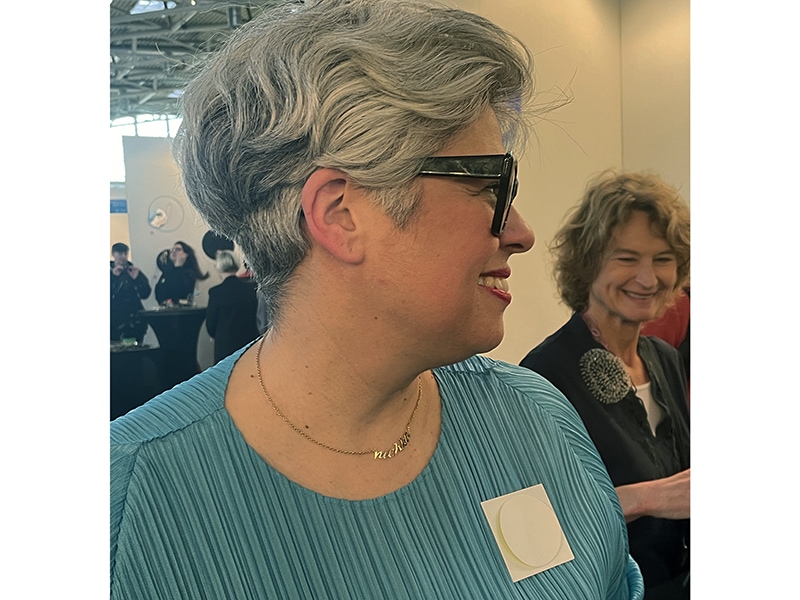
Nichka Marobin: This is where our community gathers
This year, Nichka Marobin’s primary motivation for coming to Munich is the launch of her curatorial project, The Blue Room, and its site-specific exhibition at the Messe, A Tale of Multiple Worlds | Synthesis and Possibilities on Colours and Preciousness. For the exhibition, six makers are each showing seven brooches. As a theme, they used the colors white, red, black, blue, yellow, green, and violet, with each grouping of colors presented together on the table. As in all of the historian and independent curator’s previous exhibition projects, several worlds cross. The aim is to share a multiplicity of ideas, insights, and visions.
Marobin, who is Italian and has curated a number of exhibitions in Barcelona—at JOYA, the Museu del Modernisme, and Hannah Gallery—has attended Munich’s jewelry week 15 times since 2008. And why does she continue to come year after year? “For the people, first,” she says. She can see and spend time with friends and all the artists she’s worked with over the years. “This is where our community gathers. And friends are important.” And then there’s the contest, the exhibitions, the documentation, and the sentimental journey—always significant. Instagram.

Darius Wojdyga: The networking and exchanging of ideas is invaluable
I saw Darius Wojdyga at several different events, and he may well be the best-dressed man attending Munich’s jewelry week. Wojdyga hails from Poland but currently lives in Oslo, where he’s studying for his master’s degree under Jorge Manilla, Camilla Luihn, Olaf Tønnesland Hodne, Aron Li, and Camilla Løw. He makes jewelry from discarded items he finds in the river, and pulled out his phone to show me photos of himself in a wet-suit searching for materials in the ice- and snow-covered water.
Wojdyga calls himself a “fresh” jewelry artist, and this is his third time in attendance here. He has a number of reasons for coming. First is the group exhibition with his fellow students at the Faculty of Metal- and Jewellery Art at Oslo National Academy of the Arts, which they’re presenting in Gisbert and Rose Stach’s studio in Munich. This show is an important moment in their education because, in addition to exhibition practice, “we gain knowledge about our field, we can meet ‘stars’ that have established the field of art jewelry, establish collaborations, and learn a lot from lectures, presentations, and artist talks,” he explains.
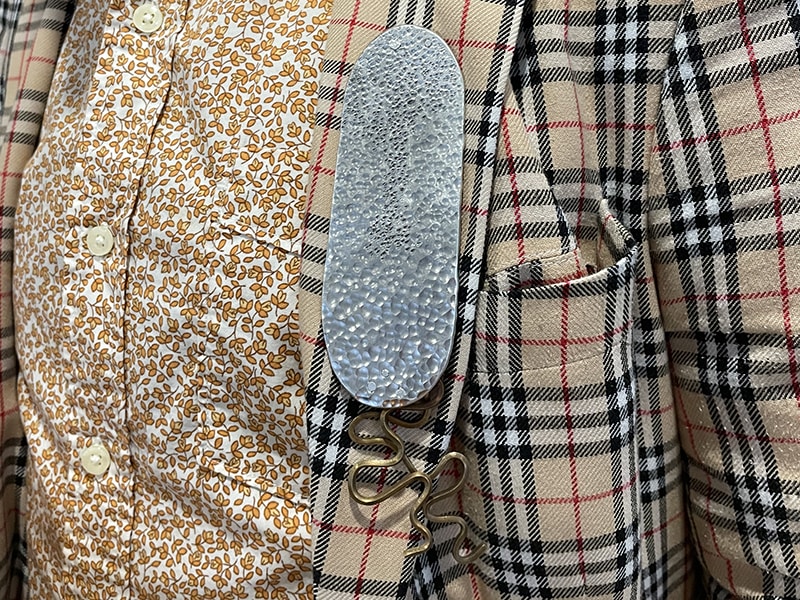
Second reason: attending Sigurd Bronger’s retrospective exhibition at the Pinakothek Der Moderne. Bronger was Wojdyga’s assigned tutor for the three years of his bachelor’s degree. “Because we represent different generations and different points of view on the world, our cooperation was full of meaningful arguments and valuable discussions,” says Wojdyga. Next reason is Jorge Manilla solo exhibition, Primitive Impulses, at the Kunstgiesserei. “Jorge is a huge source of inspiration and knowledge,” says Wojdyga. “It’s great to see his raw pieces arranged in such an interesting place.” Besides exhibitions, Wojdyga values the lectures, artist talks, and presentations in Munich. He particularly enjoyed listening to Keith Lewis, Su San Cohn, and the Young Artist Award winner and finalists.
Finally, the networking and exchange of ideas possible here are very important. Meeting old friends and making new contacts is of great value, allowing for possible future collaborations and exhibitions. Wojdyga also trades jewelry with friends or artists he’s just met. “This year I exchanged with almost the entire Let’s Get Astonished collective—Adriana Almeida Meza, Gina Nadine Müller, Julia Obermaier, Sharareh Aghaei, Stephie Morawetz, and Vesal Bahmani Nik,” he says. He also swapped with Tatiana Chorna, from the Ukrainian collective at the Messe. Finally, Wojdyga gets to enjoy the successes of his friends, including Empar Juanes Sanches, who received the Herbert Hofmann Prize, and Anna Avits, who was awarded the BKV-Preis für Junges Kunsthandwerk. Website. Instagram.
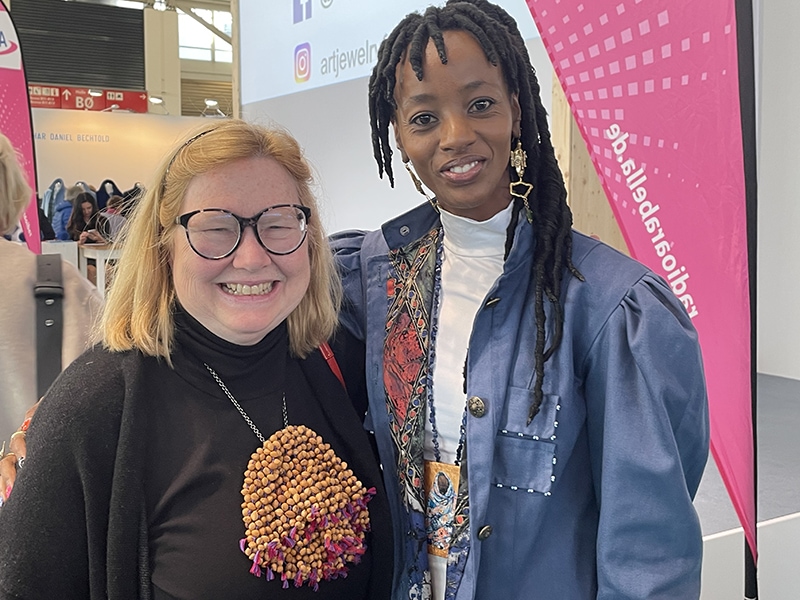
Marion Fulk: It’s an amazing few days that comes but once a year
The American collector Marion Fulk comes to Munich for the jewelry, of course, and also to see the other people drawn to the city like moths fluttering to light. “Because there is so much wonderful jewelry in one place at one time,” she says, “there is also a wonderful assembly of jewelry aficionados. I’ve made good friends who live around the world, and who I may only see once a year.” Fulk estimates that she has been to jewelry week 10 times. “I love having breakfast or lunch or dinner or coffee or wine with fellow collectors, artists, curators, writers, and gallerists who I admire and whose work I love.” She deeply enjoys attending the fair and seeing the many shows at galleries, popups, and the museum. “It’s just an amazing few days that comes once a year,” she says.

Anna Börcsök: To experience the exhibitions
This year marks the sixth time the Hungarian contemporary jewelry researcher Anna Börcsök has attended Munich’s jewelry week. She has come primarily to see the special show Schmuck 2024 at the Messe, because three pieces from her latest series, Hommage, were selected for it. “I am eager to personally experience the exquisite exhibitions,” she says, “and also seek recommendations for future appearances. Additionally, I am in the process of planning a new narrative jewelry exhibition with one of my colleagues.” Website. Instagram.
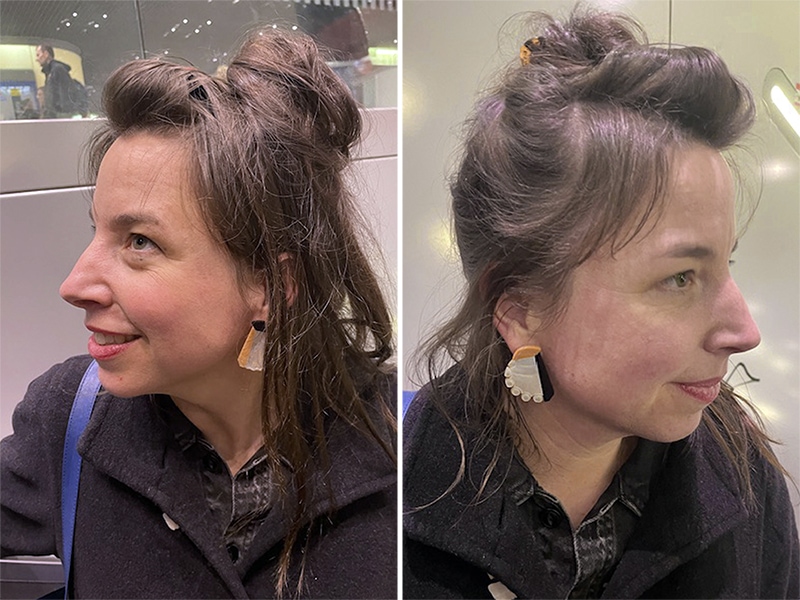
Danni Schwaag: Coming here is like being understood—a good, safe feeling
I bumped into Danni Schwaag in a subway station—a friend who knows her introduced us. The German maker lives in Bremen, in the north of the country. She first attended Munich’s jewelry week in 2009, when her diploma work was selected for the Schmuck special show. Since then, she has been back seven or eight times.
Her main reason for attending is to meet friends, the art-jewelry world, jewelry lovers, and other people she feels connected to. It’s also fun to see the exhibitions and new work by other artists. Because it’s such a small field, the art jewelry bubble feels very special, she says. “During studies it’s so natural to be surrounded by people who think the same, who speak the same language,” says Schwaag, but after graduation and after moving to a different city, you enter a different world. So “coming to Munich once a year is always like being understood. It’s a good, safe feeling.” Website. Instagram.

Sanna Svedestedt: To build connections
Sanna Svedestedt is an art jeweler from Sweden. In the past, she had come every year since graduation, but then life happened, and she was balancing starting a family, making art, and making a living. This is her first time back to jewelry week in eight years. “I really wanted to come this year because I’m working my way back into the field,” she says, “and it felt very important to see what’s been going on. It’s so vibrant, so full of life and energy, and so many talented artists.” She describes the field as open and generous. She has found it easy to interact with people and build connections. “I’m delighted!” Website. Instagram.

Saskia van Es: Book launches and discovering new gems
Saskia van Es is a Dutch art historian. She teaches jewelry history and theory at Sint Lucas, in Antwerp, Belgium, and writes regularly for AJF and Klimt02. This year is her fourth time at Munich’s jewelry week. “I looked forward to attending book launches,” she says, “like that of Daniel Kruger’s The Unexpected Meaning of Curious Things. I got hold of the little book Short Stories, by Peter Bauhuis and Kim Buck. Keith Lewis presenting his Dead Souls was both the most eloquent and the most personal book presentation I have ever been to. The event around the latest The Vessel magazine, on tattooing, with guest editor Maria Viiros, was inspiring, too. I got to see jewelry by makers I admire (Birgit Thalau! Jasmin Matzakow’s stinging nettle work, finally in real life!).” And, as she’d hoped, along the way van Es has discovered some gems previously unknown to her. Website. Instagram.
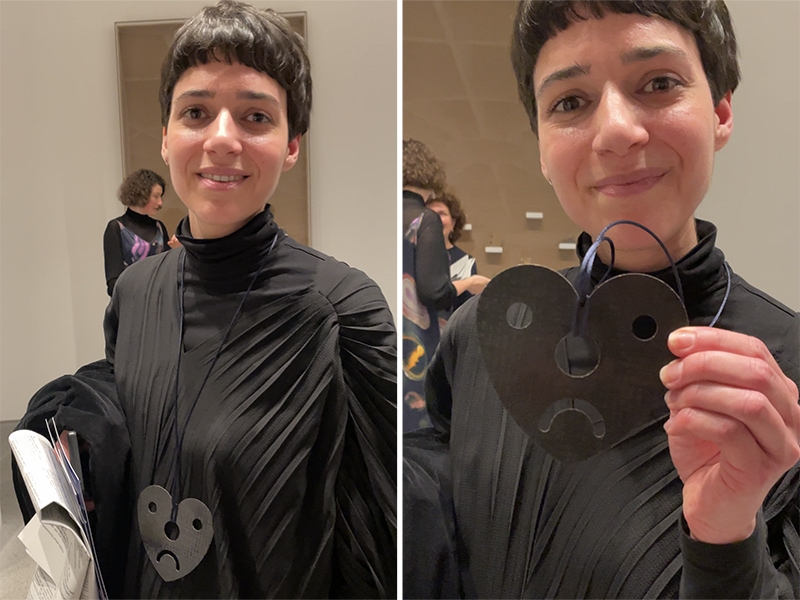
Anneleen Swillen: Seeing current developments in the field
Anneleen Swillen first heard about MJW as a BA student, around 2011 or 2012. Since then, she has missed only a few editions, so this year is her ninth or 10th visit. Swillen is a postdoctoral researcher and tutor at PXL-MAD School of Arts and Hasselt University, in Belgium. Her work revolves around the exploration of jewelry in a phygital culture through research in the arts, education, curation, and writing. In 2020, she founded “Artificial Intelligems” in collaboration with the composer and computer artist Greg Scheirlinckx. As a fluid collective, currently working at the intersection of jewelry, graphic design, music, XR-performance, dance, and data science, they aim to explore more-than-human co-creation.
“My main reasons for attending MJW are always visiting exhibitions, seeing work, meeting people,” says Swillen. “Overall, to feel inspired and get an impression of current developments in the field.” Additionally, this year she’s putting on an exhibition called Visions, Ventures & Valuables with the jewelry artists and fellow researchers Maria Konschake and Liesbet Bussche. It showcases the latest work from their research in the arts at PXL-MAD School of Arts and Hasselt University. Website. Instagram.
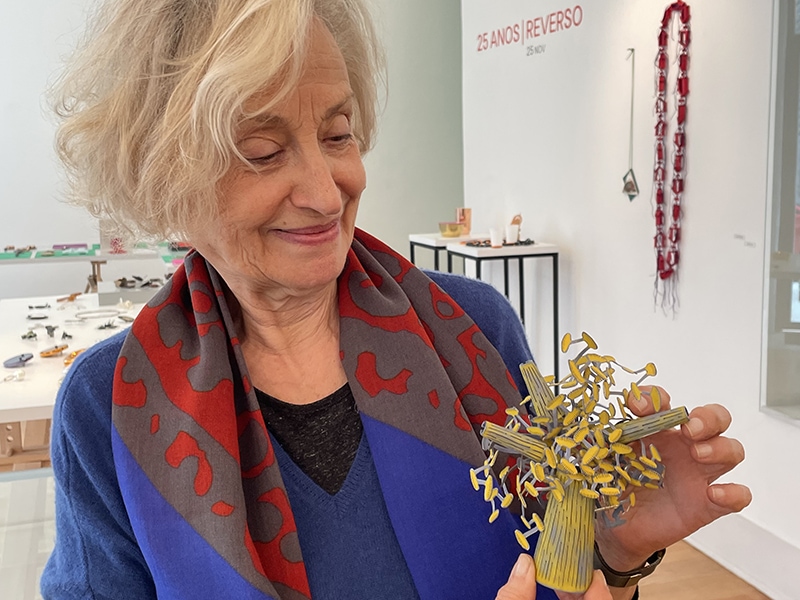
Paula Crespo: To meet artists
Paula Crespo owns Galeria Reverso, in Lisbon. She had a few pretexts for coming to Munich—for one thing, returning some of Caroline Broadhead and Lin Cheung’s jewelry, which she’d had in the gallery, to them. (Customs hassles make it troublesome to ship packages to the UK.) She also wanted to see the Sigurd Bronger exhibition, to which she has loaned a piece. She enjoys his work very much—it’s quite special—and she likes him as a person.
But there is a third reason. Roughly a year ago, she discovered the work of an artist on Instagram, someone she had never come across before. “This is different, this is so fantastic!” she thought. “But who is this guy?” She wrote him, and in the course of their correspondence, he proposed having a show of his work at her gallery. However, she’s been wanting to slow down the pace of her exhibitions, so she suggested they discuss it later. But who should she find out was making the selections for the Schmuck special exhibition? That same maker: Norman Weber! And so she simply had to come to Munich to speak with him. “The night before I went to the Messe, I could not sleep, because I knew that I was going to offer him an exhibition,” she says. That show will take place in 2025. “When I see work that I like, I want to share this, I want to show it, people must see it!” Website. Instagram.
Why did you attend Munich’s jewelry week? We welcome your comments on our publishing, and will publish letters that engage with our articles in a thoughtful and polite manner. Please submit letters to the editor electronically; do so here.
© 2024 Art Jewelry Forum. All rights reserved. Content may not be reproduced in whole or in part without permission. For reprint permission, contact info (at) artjewelryforum (dot) org




